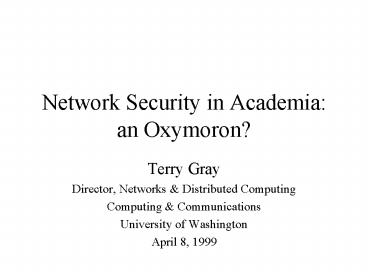Network Security in Academia: an Oxymoron - PowerPoint PPT Presentation
1 / 16
Title:
Network Security in Academia: an Oxymoron
Description:
Network Security in Academia: an Oxymoron? Terry Gray ... Almost everyone wears more than one hat. Traditional network security measures are based on physical ... – PowerPoint PPT presentation
Number of Views:79
Avg rating:3.0/5.0
Title: Network Security in Academia: an Oxymoron
1
Network Security in Academia an Oxymoron?
- Terry Gray
- Director, Networks Distributed Computing
- Computing Communications
- University of Washington
- April 8, 1999
2
Contradictions
- Researchers want open access
- Clinicians, administrators want closed access
- Everyone wants fast access
- Almost everyone wears more than one hat
- Traditional network security measures are based
on physical locality and constrained use
3
Threats
- Probing, Sniffing (when done by foes)
- Denial of Service (DOS)
- Penetration
- Account take-over
- Connection hijacking
- Data Crimes
- Theft/Disclosure
- Corruption/Destruction
- Impersonation/Fraud (e.g. web spoofing)
4
Security is not free
- In fact Security is very expensive
- Costs include
- inconvenience
- reduced performance
- complexity management overhead requiring more
staff, more time - Use "Appropriate technology"
5
Threat Sources
- Outsiders
- Insiders
- Outsiders who become insiders
- Insiders who become outsidersgtgt Benign neglect
is also a threat!
6
Security Perimeters
- Physical/Topological
- site
- subnet
- host
- Logical/Organizational
- consortium or community of interest
- enterprise
- campus
- department
- workgroup
- individual
7
Security Policy
- Defining who can/cannot do what to whom...
- Identification and prioritization of threats
- Identification of assumptions, e.g.
- Security perimeters
- Trusted systems and infrastructure
- Policy drives securitylack of policy drives
insecurity
8
Security approaches (Guns, Fences, Hounddogs,
Camouflage)
- Network
- Perimeter security (Firewalls, NATs)
- Path isolation (Switches, VPNs, IPsec)
- System
- Host OS security (wrappers, patches, etc)
- Application security (SSH, SSL, Steganography...)
- Other
- Vulnerability detection
- Intrusion detection
- Better development tools and developers!
9
Security Usually Implies Isolation
- Network security network isolation
- (what's wrong with that picture?)
- Physical isolation
- Separate wires/fiber
- low-level multiplexing, e.g. TDM
- Logical isolation
- Access control
- Encryption
10
Defense in Depth
- Security is additive
- No single solution
- Examine cost/benefit of each approach vs. cost of
security incidents - Focus first on biggest vulnerabilities
- Then knock off the easy to do items
11
Cost Time Inconvenience
- In order of increasing sys-admin time
- Application security
- Vulnerability intrusion detection
- Path isolation (VPNs)
- Perimeter security (Firewalls)
- Host security
- Incident cleanup (compound frustration!)
- In order of increasing user inconvenience
- Vulnerability intrusion detection
- Application security
- Host security
- Path isolation (VPNs)
- Perimeter security (Firewalls)
- Incident cleanup
12
The Dark Side of Firewalls
- Firewalls are often viewed as a security panacea
- But they dont live up to the hype, because they
- Assume fixed security perimeter
- Give false sense of security
- May inhibit legitimate activities
- May be hard to manage
- Won't stop many threats
- Are a performance bottleneck
13
Assessing the value of Firewalls
- Let
- E of attacks originating outside firewall
- B of external attacks actually blocked
- H Number of hosts to be protected
- P Number of security policies
- Firewall Value E B H / P
- In the limit, P may approach H !
- Must weigh cost of managing v. alternatives
14
Campus Network "Firewalls(Router packet
filtering)
- Criteria
- Low impact on network performance
- High degree of campus consensus no flaming CC!
- Can't reasonably be done at end-systems
- Now
- Prevent source address spoofing
- Other possibilities under consideration
15
Even with Firewalls...
- Bad guys arent always "outside" the moat
- One persons security perimeter is anothers
broken network - Organization boundaries and filtering
requirements constantly change - Security perimeters only protect against a
limited percentage of threats must examine
entire system - Cannot ignore end-system management
- Use of secure applications is a key strategy
16
Conclusions
- Security "pay now or pay later
- No silver bullets, only thankless effort
- Computer ownership has responsibilities Each
hacked system is a threat to neighbors - Organizational boundaries rarely map to physical
topology - Suggested security priorities Application gt
Host gt Path gt Perimeter































